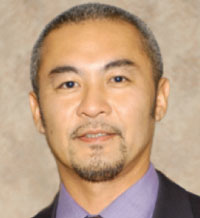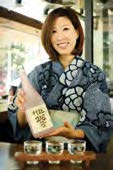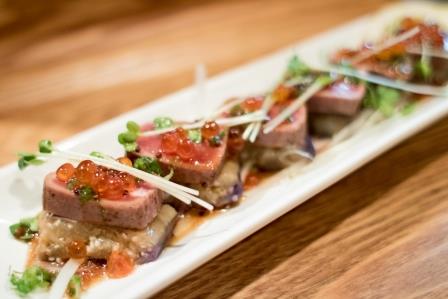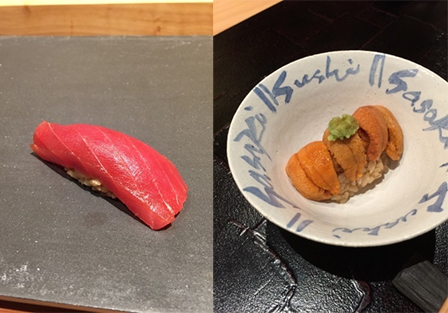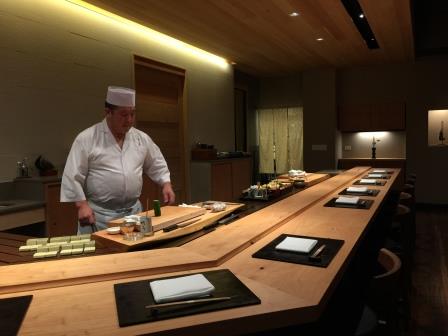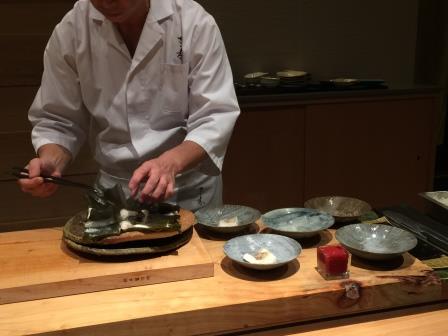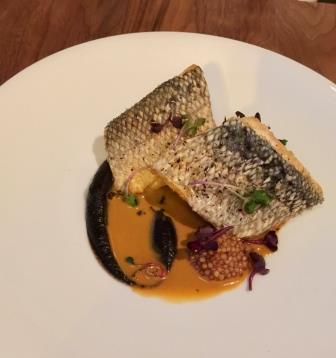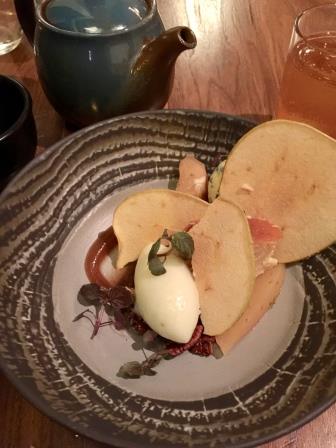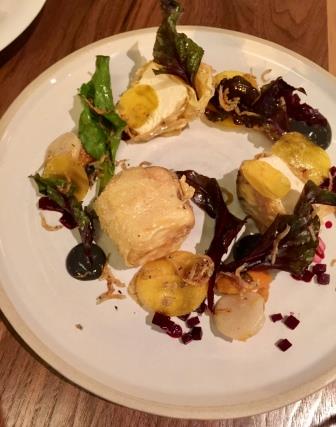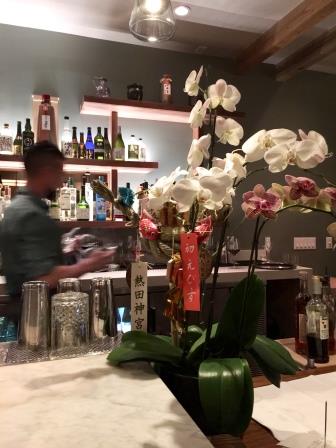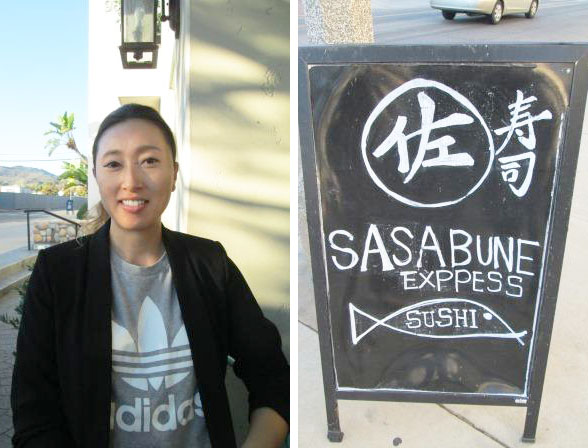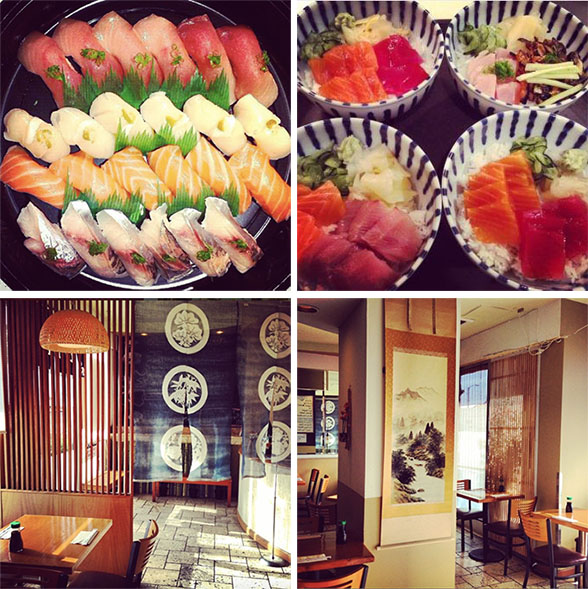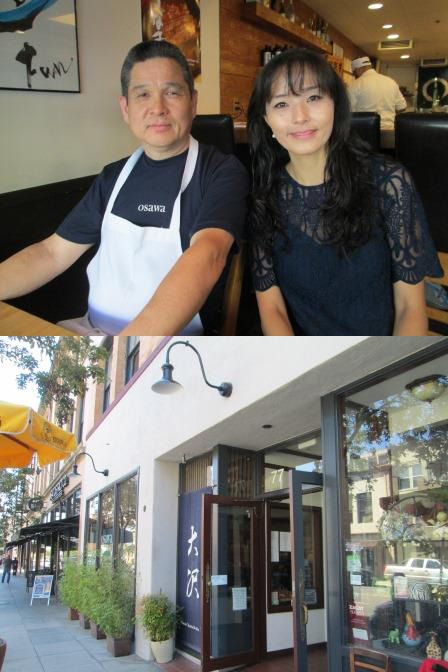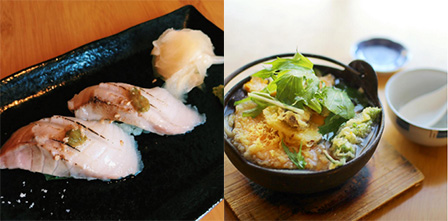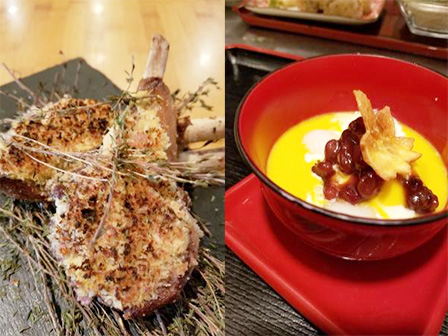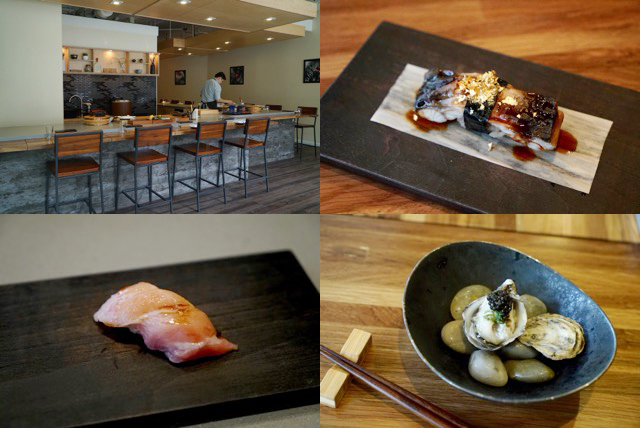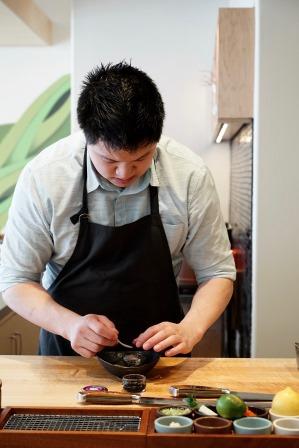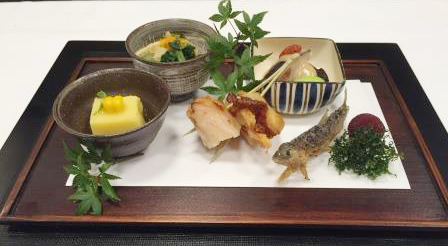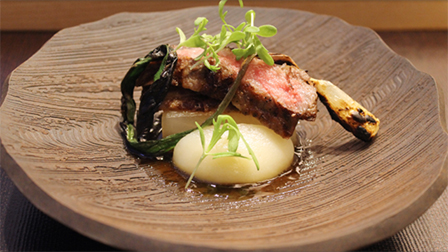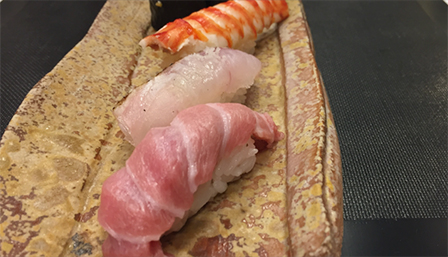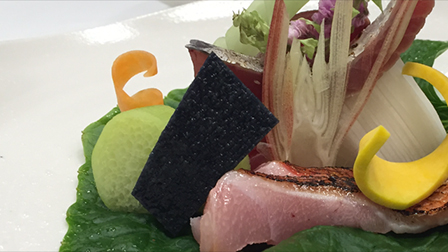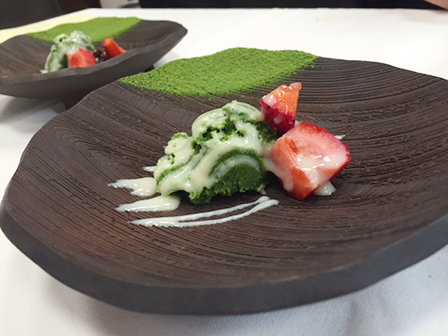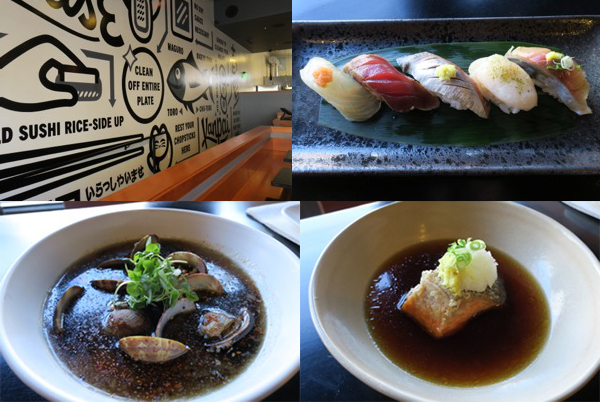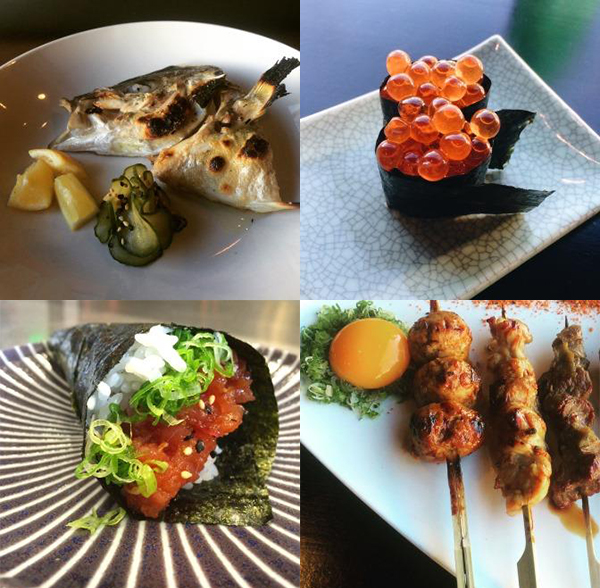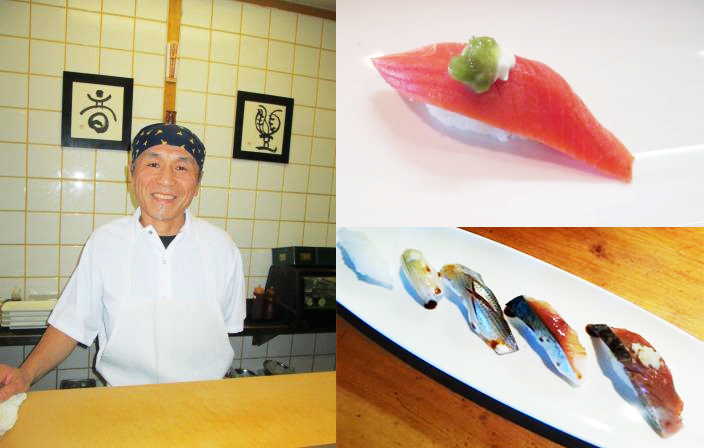A unique place that makes you feel like going back over and over again, not just because of the good price and taste
By Aya Ota
In Korean Town, where the lights are illuminated 24 hours a day, people are walking around all day long, and there are so many Korean restaurants, there is a Japanese restaurant in a corner, for which people always wait in line. This is “Izakaya Mew”. Customers start coming in as soon as the door opens at 5pm, and the place has its peaks between 6 and 8. It is so popular, and you almost always have to wait for tens of minutes to get in.
“What’s the key to your success?”
I asked. “The reasonable prices and good taste,” answered the manager, Keisuke Oku, simply. It is not easy to achieve “reasonable prices and good taste” in New York where rents are so high, and so is the competition. As I was asking deeper into the reason why they have grown to be the kind of a restaurant which can collect customers only through word of mouth with almost no advertising, but through repeated trial and error, and creating a virtuous cycle since the opening, I was finally able to see the true reason.
One reason is its location. Despite the standard for the restaurant locations in New York being on the surface of the streets, they dared to choose a basement to cut the cost in half. Naturally, the entrance is inconspicuous with a quiet sign and noren on top of the stairs that lead to downstairs. Despite the fact that it is so easy to miss even if you know the location, customers who seek “reasonable prices and good taste” form a line. There is more. They do not take reservations.
They used to take reservations at the beginning, but it tended to create empty time and tables. So they stopped taking reservations, and instead, started to take in the next group of waiting customers as soon as a table became available. This change made the operation more effective. Of course, they have to make customers wait, but customers do not complain at all. Some wait in the bar area created as a waiting space for drinking, or leave names and come back later.
They know that once they are seated, “reasonable priced and good tasting food” is waiting to be served. Among many restaurants in Korean Town which are open 24 hours a day, they close relatively early, which is another key to running the restaurant effectively.
In the menu, you find over 100 izakaya style dishes in total which are rich in ingenuity. The items are categorized as “Toriaezu”, “Tataki”, “Hot Pot”, “Deep Fried”, “Salads”, “Grilled”, “Stir Fried”, “Noodles”, “Ramen”, “Rice”, “Sushi Rolls”, “Desserts, etc. Izakaya specialty menu items are difficult to visualize just from the names, but each item is photographed to make it easy to know what it is and its volume. “Salmon Sashimi Tacos” ($7.95), a popular dish, has familiar ingredients of sauce marinated salmon and guacamole, and is well received for its unique creation as tacos. “Omu Soba” ($11.95), which is omelet wrapped yakisoba topped with dried bonito shavings and green seaweed flakes (ao-nori), is a very familiar item for Japanese people, but attracts curiosity of non-Japanese customers. Their 5 main chefs are supposed to come up with new seasonal menu items every month to make it possible to satisfy even the repeating customers by continuing to offer different dishes. Among those new items which became popular, some would be added to the standard regular menu, so the menu is kept fresh with those constant changes.
Mr. Oku continues, “I want to convey the izakaya culture of Japan.” This restaurant is highly claimed by Trip Advisor, and attracts tourists from both inside and outside the US. Since many of them are not familiar with the izakaya style, they also teach them how to enjoy izakaya. “You can place food orders any time at your own pace,” and “Dishes are meant to be shared with everyone in the group” are some of the teachings. Those who used to be unfamiliar at the beginning get soon familiarized, and can truly enjoy the unique style. In order to convey the izakaya-like ambiance, they pay close attention to create a lively atmosphere. One-of-a-kind, nostalgic interior decorations and vintage furniture helps to create such the unique ambiance, which may also be one of the reasons why they are so popular among the customers in their 20’s and 30’s.
“Izakaya Mew” has just entered its 5th year this summer. Please visit this undeniably charming restaurant which not only offers “reasonable prices and good taste”, but also makes you feel like going back over and over again.
安くて美味しいだけじゃない、何度も通いたくなる独特の店
24時間灯りがともり、人々の往来が途絶えない街、コリアンタウン。韓国料理店がひしめき、日本食店がほとんど存在しないこの地域の一角に、行列の絶えない日本食店が存在する。『Izakaya Mew』——夕方5 時の開店と共に、続々と客が入ってきて、6 〜7 時台にはピークを迎え、常に数十分待ちの行列ができる人気店だ。
「成功の秘訣は?」との問いに、「安くて美味しい」とシンプルに答えるのは、同店のマネージャー、奥慶介氏。家賃が高く競争の厳しいニューヨークで“ 安くて美味しい” を実現するのは決して簡単なことではない。さらに深く掘り下げて聞くと、開店以来、試行錯誤を重ね、好循環を作りだし、ほとんど宣伝することなしに口コミで集客できる店に成長した理由を伺い知ることができた。
まずは、立地条件。ニューヨークでは、レストランの立地は路面が常識と考えられているが、あえて地下を選んだことで、家賃を路面の約半額に抑えている。当然、入り口は目立たず、地下に降りる階段のあたりに、ひっそりと暖簾と看板があるのみ。場所を知っていてもうっかり通り過ぎてしまうほどだが、客は“ 安くて美味しい” を目指して列を作る。もう一つの特徴は予約を取らないこと。開店当初は予約を取っていたが、どうしても空き時間や空席ができてしまう。そこで、予約を取らず、席が空き次第、次の客を入れるようにオペレーションを変更した結果、効率が上がったという。当然、客を待たせることになるが、ウェイティング・スペースとなっているバーで一杯飲みながら待つ客もいれば、名前を書いて外に出て戻ってくる客もいる。いったん着席すれば “ 安くて美味しい” が待っていると分かっているので、客からのクレームは一切ない。24 時間開店している店も珍しくないこのコリアンタウンで、閉店時間が早いのも特徴的で、これも効率のよいオペレーションに一役買っている。
メニューには、創意工夫に富んだ居酒屋料理が並んでいる。「とりあえず」に始まり、「たたき」「鍋」「揚げ物」「サラダ」「焼き物」「炒め物」「麺類」「ラーメン」「ご飯物」「寿司ロール」「デザート」という具合にカテゴリ分けされており、その数は約100 種類にも及ぶ。居酒屋特有の料理にはメニュー名を見ただけでは、内容を想像しにくいものも多いが、すべてのメニューに写真が掲載されており、量や内容をイメージしやすい。人気メニューの『サーモン刺身タコス』($7.95)は、タレに漬け込んだサーモンとワカモレという馴染みの食材を使いつつも、タコスに仕上げるという異色の組み合わせが受けている。焼きそばをオムレツで包み、鰹節と青のりを振りかけた『オムソバ』($11.95)は、日本人には馴染みがある居酒屋メニューだが、非日本人には好奇心をそそる。同店では、メインのシェフ5 人が、毎月、季節感あふれる新作メニューを提案することになっており、リピーター客を飽きさせることもない。季節の新作メニューで人気が出たものは定番メニューに投入し、常にメニューの入れ替えを図っているので、常に新鮮だ。
「日本の居酒屋文化を伝えたい」と奥氏は続ける。同店は、トリップアドバイザーで高評価を得ていることから、米国内外からの観光客も多く、居酒屋を知らない客も多い。「いつでも好きなタイミングで料理を注文できること」「みんなでシェアして食べること」など、居酒屋の楽しみ方を教えている。はじめは不慣れだった客も、居酒屋独自のスタイルを満喫しているという。居酒屋らしさを伝えるためにも、活気あふれる雰囲気作りにも気を配っている。独特でノスタルジックな雰囲気を醸し出すインテリアやヴィンテージ感ある家具や調度品も特徴的だ。このお洒落さも20 〜30代を中心に人気がある理由の一つなのだろう。
この夏から5 年目に突入した『IzakayaMew』。安くて美味しいだけじゃない、何度も通いたくなる不思議な魅力のある店、ぜひ足を運んでみてほしい。
Izakaya Mew
Basement, 53 West 35th Street
New York, NY 10001
(646) 368-9384
http://mewnyc.com
LUNCH: Mon-Fri 12:00pm-2:20pm
DINNER: Mon-Thurs 5:00pm-10:30pm
Fri & Sat 5:00pm-11:30am
Sun 5:00pm-10:00pm
In Korean Town, where the lights are illuminated 24 hours a day, people are walking around all day long, and there are so many Korean restaurants, there is a Japanese restaurant in a corner, for which people always wait in line. This is “Izakaya Mew”. Customers start coming in as soon as the door opens at 5pm, and the place has its peaks between 6 and 8. It is so popular, and you almost always have to wait for tens of minutes to get in.
“What’s the key to your success?”
I asked. “The reasonable prices and good taste,” answered the manager, Keisuke Oku, simply. It is not easy to achieve “reasonable prices and good taste” in New York where rents are so high, and so is the competition. As I was asking deeper into the reason why they have grown to be the kind of a restaurant which can collect customers only through word of mouth with almost no advertising, but through repeated trial and error, and creating a virtuous cycle since the opening, I was finally able to see the true reason.
One reason is its location. Despite the standard for the restaurant locations in New York being on the surface of the streets, they dared to choose a basement to cut the cost in half. Naturally, the entrance is inconspicuous with a quiet sign and noren on top of the stairs that lead to downstairs. Despite the fact that it is so easy to miss even if you know the location, customers who seek “reasonable prices and good taste” form a line. There is more. They do not take reservations.
They used to take reservations at the beginning, but it tended to create empty time and tables. So they stopped taking reservations, and instead, started to take in the next group of waiting customers as soon as a table became available. This change made the operation more effective. Of course, they have to make customers wait, but customers do not complain at all. Some wait in the bar area created as a waiting space for drinking, or leave names and come back later.
They know that once they are seated, “reasonable priced and good tasting food” is waiting to be served. Among many restaurants in Korean Town which are open 24 hours a day, they close relatively early, which is another key to running the restaurant effectively.
In the menu, you find over 100 izakaya style dishes in total which are rich in ingenuity. The items are categorized as “Toriaezu”, “Tataki”, “Hot Pot”, “Deep Fried”, “Salads”, “Grilled”, “Stir Fried”, “Noodles”, “Ramen”, “Rice”, “Sushi Rolls”, “Desserts, etc. Izakaya specialty menu items are difficult to visualize just from the names, but each item is photographed to make it easy to know what it is and its volume. “Salmon Sashimi Tacos” ($7.95), a popular dish, has familiar ingredients of sauce marinated salmon and guacamole, and is well received for its unique creation as tacos. “Omu Soba” ($11.95), which is omelet wrapped yakisoba topped with dried bonito shavings and green seaweed flakes (ao-nori), is a very familiar item for Japanese people, but attracts curiosity of non-Japanese customers. Their 5 main chefs are supposed to come up with new seasonal menu items every month to make it possible to satisfy even the repeating customers by continuing to offer different dishes. Among those new items which became popular, some would be added to the standard regular menu, so the menu is kept fresh with those constant changes.
Mr. Oku continues, “I want to convey the izakaya culture of Japan.” This restaurant is highly claimed by Trip Advisor, and attracts tourists from both inside and outside the US. Since many of them are not familiar with the izakaya style, they also teach them how to enjoy izakaya. “You can place food orders any time at your own pace,” and “Dishes are meant to be shared with everyone in the group” are some of the teachings. Those who used to be unfamiliar at the beginning get soon familiarized, and can truly enjoy the unique style. In order to convey the izakaya-like ambiance, they pay close attention to create a lively atmosphere. One-of-a-kind, nostalgic interior decorations and vintage furniture helps to create such the unique ambiance, which may also be one of the reasons why they are so popular among the customers in their 20’s and 30’s.
“Izakaya Mew” has just entered its 5th year this summer. Please visit this undeniably charming restaurant which not only offers “reasonable prices and good taste”, but also makes you feel like going back over and over again.
安くて美味しいだけじゃない、何度も通いたくなる独特の店
24時間灯りがともり、人々の往来が途絶えない街、コリアンタウン。韓国料理店がひしめき、日本食店がほとんど存在しないこの地域の一角に、行列の絶えない日本食店が存在する。『Izakaya Mew』——夕方5 時の開店と共に、続々と客が入ってきて、6 〜7 時台にはピークを迎え、常に数十分待ちの行列ができる人気店だ。
「成功の秘訣は?」との問いに、「安くて美味しい」とシンプルに答えるのは、同店のマネージャー、奥慶介氏。家賃が高く競争の厳しいニューヨークで“ 安くて美味しい” を実現するのは決して簡単なことではない。さらに深く掘り下げて聞くと、開店以来、試行錯誤を重ね、好循環を作りだし、ほとんど宣伝することなしに口コミで集客できる店に成長した理由を伺い知ることができた。
まずは、立地条件。ニューヨークでは、レストランの立地は路面が常識と考えられているが、あえて地下を選んだことで、家賃を路面の約半額に抑えている。当然、入り口は目立たず、地下に降りる階段のあたりに、ひっそりと暖簾と看板があるのみ。場所を知っていてもうっかり通り過ぎてしまうほどだが、客は“ 安くて美味しい” を目指して列を作る。もう一つの特徴は予約を取らないこと。開店当初は予約を取っていたが、どうしても空き時間や空席ができてしまう。そこで、予約を取らず、席が空き次第、次の客を入れるようにオペレーションを変更した結果、効率が上がったという。当然、客を待たせることになるが、ウェイティング・スペースとなっているバーで一杯飲みながら待つ客もいれば、名前を書いて外に出て戻ってくる客もいる。いったん着席すれば “ 安くて美味しい” が待っていると分かっているので、客からのクレームは一切ない。24 時間開店している店も珍しくないこのコリアンタウンで、閉店時間が早いのも特徴的で、これも効率のよいオペレーションに一役買っている。
メニューには、創意工夫に富んだ居酒屋料理が並んでいる。「とりあえず」に始まり、「たたき」「鍋」「揚げ物」「サラダ」「焼き物」「炒め物」「麺類」「ラーメン」「ご飯物」「寿司ロール」「デザート」という具合にカテゴリ分けされており、その数は約100 種類にも及ぶ。居酒屋特有の料理にはメニュー名を見ただけでは、内容を想像しにくいものも多いが、すべてのメニューに写真が掲載されており、量や内容をイメージしやすい。人気メニューの『サーモン刺身タコス』($7.95)は、タレに漬け込んだサーモンとワカモレという馴染みの食材を使いつつも、タコスに仕上げるという異色の組み合わせが受けている。焼きそばをオムレツで包み、鰹節と青のりを振りかけた『オムソバ』($11.95)は、日本人には馴染みがある居酒屋メニューだが、非日本人には好奇心をそそる。同店では、メインのシェフ5 人が、毎月、季節感あふれる新作メニューを提案することになっており、リピーター客を飽きさせることもない。季節の新作メニューで人気が出たものは定番メニューに投入し、常にメニューの入れ替えを図っているので、常に新鮮だ。
「日本の居酒屋文化を伝えたい」と奥氏は続ける。同店は、トリップアドバイザーで高評価を得ていることから、米国内外からの観光客も多く、居酒屋を知らない客も多い。「いつでも好きなタイミングで料理を注文できること」「みんなでシェアして食べること」など、居酒屋の楽しみ方を教えている。はじめは不慣れだった客も、居酒屋独自のスタイルを満喫しているという。居酒屋らしさを伝えるためにも、活気あふれる雰囲気作りにも気を配っている。独特でノスタルジックな雰囲気を醸し出すインテリアやヴィンテージ感ある家具や調度品も特徴的だ。このお洒落さも20 〜30代を中心に人気がある理由の一つなのだろう。
この夏から5 年目に突入した『IzakayaMew』。安くて美味しいだけじゃない、何度も通いたくなる不思議な魅力のある店、ぜひ足を運んでみてほしい。
Izakaya Mew
Basement, 53 West 35th Street
New York, NY 10001
(646) 368-9384
http://mewnyc.com
LUNCH: Mon-Fri 12:00pm-2:20pm
DINNER: Mon-Thurs 5:00pm-10:30pm
Fri & Sat 5:00pm-11:30am
Sun 5:00pm-10:00pm

